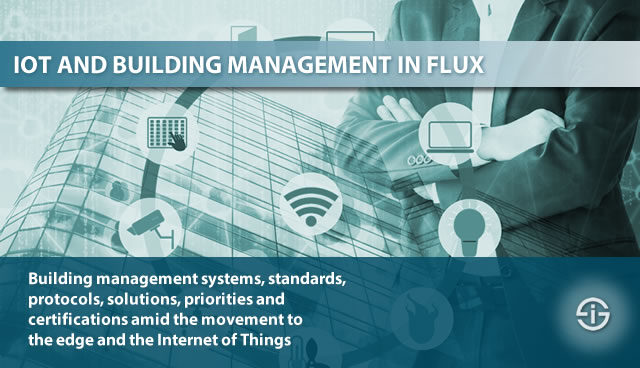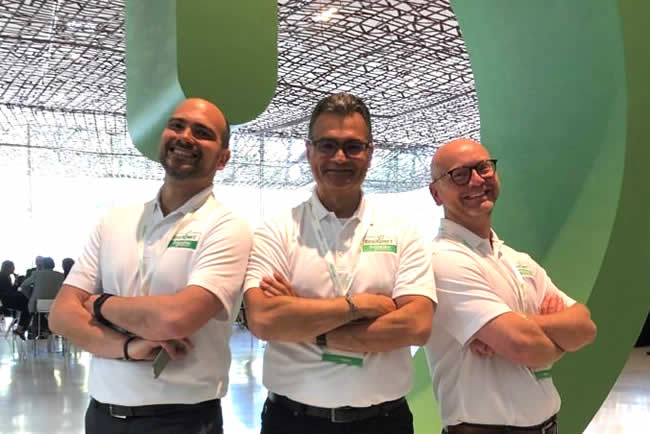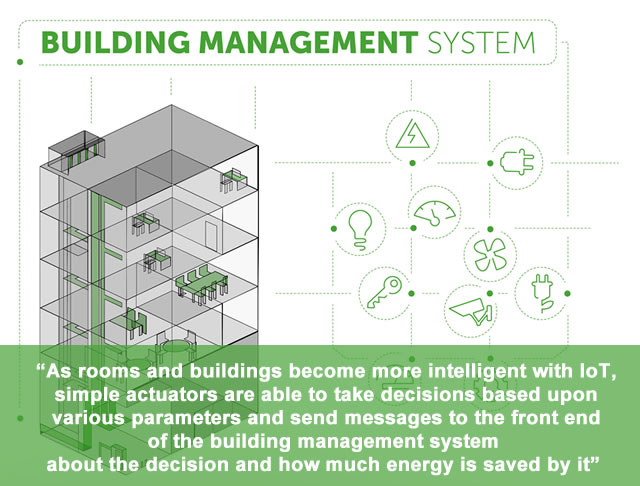A deep dive into the past, present, and future of building automation, focusing on the impact of evolving stakeholder demands, ongoing digitization, emerging smart building technologies, the impact/role of IoT and IP, the shift to Industry 4.0, and intelligent BMS systems.
The building automation market is changing rapidly. The data-enabled possibilities facilitated by the Internet of Things (IoT) and smart sensors impact the industry with smart buildings as one of the fastest-growing cross-industry IoT use cases.

Along with these – and other – technological enablers and drivers, the growing focus on energy efficiency, ecological footprint, the digital transformation of the AEC industry, and evolving views on the built environment are also crucial in the evolution of the building management landscape.
Someone who knows everything about the past, present, and future of building automation and building management systems (BMS) is Martin Feder.
Martin is, among others, responsible for the BMS partner and certification badge of EcoXpert, the partner program of Schneider Electric. He has over 30 years of experience in the BMS field and takes us through a journey across the building automation evolutions, challenges, standards, drivers, and solutions.
For a few years, the awareness that integrated building management systems are the integrated digital hub of the building instead of the IT system has grown (Martin Feder)
As you will discover, it is an increasingly accelerating reality whereby IoT is moving from its initial role in the management and control levels of building automation to an expanded usage across the entire building towards the edge with intelligent management systems.
The evolving skill sets of BMS integrators: from HVAC to programming and networking skills
Martin, can you start by telling us more about the BMS badge and the types and background of companies that are part of it and thus active in the BMS market?
Martin Feder: The Building Management badge is predominantly for system integrators and partner companies working in the building management and building automation field.
EcoXpert partners in BMS mainly have a mechanical HVAC (heating, ventilating, and air conditioning) background. Some are run by former employees of vendors in this space who decided to launch their own business to serve customers. Others are long-standing companies that have been in the HVAC market for several decades and were passed on to the next generations or acquired by other companies.
The role of the BMS has changed several times. Today it retakes the center stage. Yet, now the place of the BMS as the building’s digital hub and center of connectivity is highly transformational (Martin Feder)
It’s an evolving landscape, whereby the Internet of Things is a crucial game-changer, although the typical BMS business partner has already evolved a lot in the last 30 to 40 years.
Since their traditional main background is mechanical, BMS partners initially provided relatively simple automation services for HVAC equipment such as boilers, air handling units, chillers, and heat pumps in commercial buildings. Over the years, their skill set moved from traditional HVAC controls and understanding essential thermal dynamics of creating heat or cooling in a building to more advanced skills.
These include programming and networking skills at a proprietary level as the technology evolved to control systems and integration into third-party systems. For instance, they learned about how lighting and fire systems work and about security access control and video technology. Most BMS partners don’t install the latter systems, but they can connect to them. However, this is changing too, where the Internet of Things comes even more into the picture.
Today they are looking at this new challenge and opportunity to move to an entire Internet Of Things approach, which requires open IP protocols connectivity and network design, using hubs. Some of them already are used to this, but for most, it is a significant change.
The BMS as the central integration center
So, it has increasingly become a mixed environment in the ongoing integration of IT and OT (information technology and operational technology), in this case in the BMS space, with the need to combine several skill sets for a more future-proof offering as the importance of IoT increases. What are some challenges in this regard?
Martin Feder: The integration of IT and OT is indeed key. One challenge for partners is understanding how they can bring these two technologies together to create a building that will add value to the customer.
Interestingly, this convergence and integration, along with changing demands, puts building management more central again. This is also related to the growing importance of energy in the whole building management equation. In a sense, that also brings us back in time.
In the early days of building management, the systems were called building energy management systems (BEMS). Then people started dropping the ‘E’ and talked about a building management system instead of an energy system.
Later on, with the advent of the IT world of things, buildings were designed around network connectivity. And about ten years ago, regulations and certifications such as LEED (the certificate of the US Green Building Council) brought back the energy dimension in building management.
The main factors putting the BMS in the center again are the importance of energy, green buildings, all the standards, and the regulations (Martin Feder)
If you combine those evolutions, the Internet of Things and IT networks, there is somewhat of a debate about whether the entire IT needs to remain independent from the BMS or whether the BMS is part of the IT system.
As you can imagine, IT executives aren’t keen to have a BMS on the same bandwidth as the office network. These are the kind of challenges that show up and impact our BMS certification program. We also see a shift to the edge and changes in thinking about the network (editor’s note: edge computing also becomes more important in specific built environment projects where rapid IoT data analysis is required close to the source).
Building management networks and security
Your colleague, Kevin Morin, said that using separate networks can lead to security issues within his field of critical power buildings as IT cybersecurity experts are often not involved in the building networks. How do you see that?
Martin Feder: That is indeed a challenge in BMS. We have seen cases in the markets whereby controls in a critical environment were hacked. It’s an issue we have addressed for several years with Schneider Electric, as in terms of our EcoXperts, it shouldn’t become an issue.
In the BMS certification program, we provide the information BMS partners need. Yet, as a manufacturer, Schneider Electric also designs and builds its products with security by design in mind. To do so, we follow a US military standard which used to be known as DIACAP and has been moved to a more public domain framework, now called DIARMF (Defense Information Assurance Risk Management Framework).
We put these protocols and test procedures into our products and then run through the procedures to ensure that customers have the latest antivirus and anti-hack profiles in any equipment. Anything with an IP connection is soon going to conform to these standards.

Intelligent building management and IoT – standards and protocols amidst the movement to the edge
Talking about standards, protocols, and what you previously said about the edge: where do you see the Internet Of Things heading with future building automation and energy management evolutions in this regard?
Martin Feder: The BMS market has been using its own proprietary communication protocols for a long time. Examples include BACnet, LON, KNX, and others that traditionally run via twisted pair, RS485 style cables.
Approximately ten years ago, building managements systems started to use these protocols over IP: BACnet/IP, LON/IP, and more.
With IP, Internet connectivity, and IT entering the market, we went through a period whereby the IT system defined the criteria for the design of the building. Those days are over and gone. (Martin Feder)
While the network architecture did not change a lot, hubs and switches entered into the BMS world. Many saw this as an opportunity to move the BMS onto the already installed IT infrastructure of the building. Still, due to the earlier mentioned concerns, there was a choice for separate networks.
Thanks to IP, which was perceived as the common ground, even if protocols were still different, this led to the ‘easier integration of other building systems and enabled the resulting increase of connectivity and information flows.
Tomorrow’s trend will be to move the field controllers, the actual control devices in the rooms and spaces, to the IP level, enabling faster connectivity of the entire BMS.
This, in turn, will allow information and decision-making to happen at the edge. The result will be more autonomous decision-making happening at the field level, whereby only the critical information is pushed up the line to the BMS visualization system.
Towards autonomous decision making with IoT
So, the networks remain separate, but the data, analytics, and insight move to the edge. Can you give an example of that more autonomous decision-making at the edge?
Martin Feder: The intelligence is indeed moving further and further in the field to the edge, away from the central part where all the data is stored and analyzed, enabling us to learn how the building operates.
For an autonomous decision-making example, let’s take a simple actuator that can decide whether it should open or close the flow of water or any other energy flow in a room. The rooms become intelligent enough with IoT and can steer decisions based upon parameters such as activity in the room, the fact that no one has come in or has gone out, and so forth.
Based upon such parameters, it will decide to reduce energy consumption by having actuators close specific parts off and send a message to the front end about this decision and about how much energy is saved this way.
What are the main IoT-enabled components used in today’s intelligent buildings, and how do you see the evolution towards field controllers from an IoT technology perspective?
Martin Feder: The two levels which have been connected are the enterprise and management levels. These consist of the computers and servers that collect all the data (enterprise) and the next level (management), which we call main plant controllers.
Those controllers are out in the field but traditionally in environments such as the boiler room or on top of the roof where they measure the cooling and air handling.
In the next step come the mentioned field controllers, which are the field level of BMS. They are the controls that you don’t see and will find, for instance, in a smart office space, hospital room, classroom, etc. They are up in the ceiling or behind a wall. You might only see a temperature sensor, the light switch, and the controls that show you a number that you can move up or down. This is the next level that is moving to the IP IT domain.
Green building regulations and certifications, ecological footprint, building energy efficiency, and, in particular, legislation are critical drivers of the building management systems market
We also see the first small actuators that sit on your radiator or control the actual airflow in a room. These slowly are also becoming connected and offer advantages such as less wiring as part of the IoT evolution.
You don’t need to keep running separate wires for communication, power, and so on. There is a view to run power over Ethernet and plug into the IP networks, making the installation time theoretically faster. Yet, some of the components in the building are motors, and here you will still need external power and some local wiring.
Energy efficiency in buildings is not a matter of choice anymore
We’ve touched upon the energy savings, energy efficiency, and ecological aspects a few times, with a clear role for regulators. Would you say that regulations, sustainability, and cost savings are the key drivers of the market?
Martin Feder: They are and in particular legislation. Before the Energy Performance and Building Directive (EPBD) was established within the European Union, having an idea of how much energy got used was one of the advantages already sought.
Since legislation arrived (in the EU and elsewhere), there is a real value attached to the energy-saving and environmental dimension and an understanding of the importance of the greenness of the planet and of energy consumption.
This is also the case in the US, for instance, where you have the Green Building Council and the previously mentioned LEED (Leadership in Energy and Environmental Design) program which is all about environmentally friendly designs of buildings and systems.

The LEED certification has spread across the globe, among others, because of the perceived value. It increases the asset price of the building, and it’s also easier to find tenants who care about ecology to move in and these are traditionally larger organizations who have their environmental group departments that will not rent a building unless it meets specific criteria. The latter is also driven by peer pressure.
Other legislation requires obtaining the building intelligence much faster than in the past. A large company such as a manufacturer in Switzerland, for example, needs to be able to tell its local authority on a year in advance basis how much energy it is going to reduce its consumption by.
So, while in the past the mentality was one of ‘you tried, you didn’t make it, next year better,’ it shifts to taxing on your energy consumption in case you missed the target. That requires a different approach whereby you need to see potential over-usage and its root causes almost in real-time.
Building analytics is part of how a building is functioning, and the data processing of all this information is expected by building owners (Martin Feder)
BMS expertise – the holistic building approach
A considerable difference whereby IoT, big data analytics, artificial intelligence, and other technologies can make much difference indeed. The last question: what is unique about the EcoXpert program and the BMS certification?
Martin Feder: It is the holistic approach, the coverage, the product portfolio of Schneider Electric and in the BMS certification scope, the acquisition of all these different skill sets which are increasingly needed and also make our program evolve.
Moreover, it’s not just about our traditional BMS management system; we can offer so much more such as the light and room control, the critical power management, Datacom, vertical solutions for retail facilities, small businesses, healthcare facilities, hotels, substation automation, and so forth.
That holistic approach is unique to Schneider Electric. It is also what we try to achieve with our multi-certification focus, whereby we want to bring a more significant part of a building project to our partners so they can do more on a single project.
Martin, thank you very much for your time and insights.
Top image: Shutterstock – Copyright: Montri Nipitvittaya – Bottom image: Shutterstock – Copyright: Sergii Khandozhko


